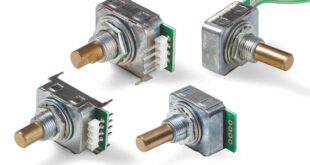Diodes Incorporated has announced new additions to its synchronous buck converter portfolio. With continuous output current ratings of 5A and 8A respectively, the AP62500 and AP62800 offer the flexibility engineers need to develop point-of-load (POL) solutions that are optimised for either efficiency or size.
Enabling compact implementations with minimal component count, these devices are targeted at use in mass-market consumer products, such as 5V and 12V distributed power bus supplies, television sets and monitors, white goods and small home appliances, FPGA, DSP, and ASIC supplies, home audio, network systems, gaming consoles, consumer electronics, and general purpose point of loads.
Both buck converters have wide input voltage ranges — with the AP62500 covering 4.5V to 18V, and the AP62800 covering 4.5V to 17V (making both suitable for 5V and 12V rail applications). Their output voltages can be adjusted down to 0.6V. Three different switching frequencies may be selected (400kHz, 800kHz, and 1.2MHz), allowing engineers to prioritise elevated conversion efficiency or focus on having a compact form factor. In addition, the devices have three selectable operating modes; pulse frequency modulation (PFM) for improved light-load efficiency, pulse width modulation (PWM) for reduced output voltage ripple, and ultrasonic (USM) for avoiding audible frequency range while ensuring the switching frequency stays above 20kHz.
On-resistance (RDS(ON)) figures are kept low in relation to both the high-side MOSFET (47mΩ for AP62500; 22mΩ for AP62800) and low-side MOSFET (18mΩ for AP62500; 10mΩ for AP62800). This helps to improve step-down conversion efficiency levels. An ultra-low quiescent current (IQ) is also achieved while in PFM mode (195μA typical), further enhancing light-load efficiencies.
The design of these buck converters minimises electromagnetic interference (EMI) issues. A proprietary gate-driver design mitigates switching-node ringing without having to extend MOSFET turn-on/turn-off times, which would otherwise impact high-frequency switching capabilities. Constant on-time (COT) control results in fast transient response and low-output voltage ripple, as well as facilitates better loop stabilisation. Soft-start time adjustability is another important feature to protect against the risk of damage from inrush currents.
 Engineer News Network The ultimate online news and information resource for today’s engineer
Engineer News Network The ultimate online news and information resource for today’s engineer





